Related Research Articles

Seventeen days after the German invasion of Poland in 1939, which marked the beginning of the Second World War, the Soviet Union entered the eastern regions of Poland and annexed territories totalling 201,015 square kilometres (77,612 sq mi) with a population of 13,299,000. Inhabitants besides ethnic Poles included Belarusian and Ukrainian major population groups, and also Czechs, Lithuanians, Jews, and other minority groups.

Rise to Rebellion is a 2001 historical fiction book by Jeff Shaara that tells the story of the events leading up to the American Revolution. The book spans from the Boston Massacre to the signing of the Declaration of Independence in 1776. The events of the American Revolution are portrayed through the perspectives of multiple characters, including Sentry Hugh White of the British army, John Adams, Benjamin Franklin, Lieutenant-General Thomas Gage, George Washington, Governor Thomas Hutchinson, Captain James Hall, Abigail Adams, Paul Revere, Dr. Joseph Warren, and Major John Pitcairn. Other characters in the book include King George the Third, George Greenville, Samuel Adams, Issac Barre, John Hancock, John Wilkes, William Pitt, Edmund Burke, Sir Charles Townshend, Sir Will Hills, Francis Bernard, Deborah Franklin, William Franklin, Martha Washington, Patrick Henry, Richard Henry Lee, General Jeffrey Amherst, Margaret Kemble Gage, Captain Thomas Preston, Josiah Quincy, Samuel Johnson, Will Strahan, John Quincy Adams, Lord Wedderburn, Thomas Paine, Lord Admiral Richard Howe, John Montagu, Paul Revere, Lieutenant Colonel Francis Smith, Captain John Parker, Walter Laurie, Admiral Graves, Ethan Allen, Benedict Arnold, Henry Clinton, John Burgoyne, Artemas Ward, William Prescott, General Putnam, Major Gridley, Charles Lee, Horatio Gates, William Tryon, Daniel Morgan, Bonvouloir, Richard Montgomery, Hiram Jones, Lady Germain, Henry Knox, Nathaniel Green, and Robert Livingston. The book covers events leading to the American Revolution, starting with what is known as "The Boston Massacre" and ending with the writing and signing of the Declaration of Independence.
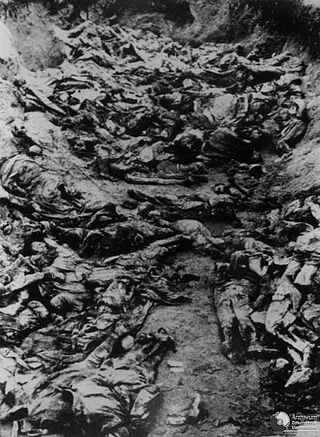
The Katyn massacre was a series of mass executions of nearly 22,000 Polish military and police officers, border guards, and intelligentsia prisoners of war carried out by the Soviet Union, specifically the NKVD, at Stalin's order in April and May 1940. Though the killings also occurred in the Kalinin and Kharkiv NKVD prisons and elsewhere, the massacre is named after the Katyn forest, where some of the mass graves were first discovered by German Nazi forces in 1943.
As a result of the Soviet invasion of Poland in 1939, hundreds of thousands of Polish soldiers became prisoners of war. Many of them were executed; 22,000 Polish military personnel and civilians perished in the Katyn massacre alone.
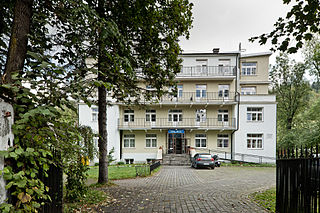
The Gestapo–NKVD conferences were a series of security police meetings organised in late 1939 and early 1940 by Germany and the Soviet Union, following the invasion of Poland in accordance with the Molotov–Ribbentrop Pact. The meetings enabled both parties to pursue specific goals and aims as outlined independently by Hitler and Stalin, with regard to the acquired, formerly Polish territories. The conferences were held by the Gestapo and the NKVD officials in several Polish cities. In spite of their differences on other issues, both Heinrich Himmler and Lavrentiy Beria had similar objectives as far as the fate of pre-war Poland was concerned. The objectives were agreed upon during signing of the German–Soviet Boundary and Friendship Treaty on 28 September 1939.

Katyń is a 2007 Polish historical drama film about the 1940 Katyn massacre, directed by Academy Honorary Award winner Andrzej Wajda. It is based on the book Post Mortem: The Story of Katyn by Andrzej Mularczyk. It was nominated for Best Foreign Language Film for the 80th Academy Awards.

Fear: Anti-Semitism in Poland after Auschwitz: An Essay in Historical Interpretation, is a book by Jan T. Gross, published by Random House and Princeton University Press in 2006. An edited Polish version was published in 2008 by Znak Publishers in Kraków as Strach: antysemityzm w Polsce tuż po wojnie: historia moralnej zapaści. In the book, Gross explores the issues concerning incidents of post-war anti-Jewish violence in Poland, with particular focus on the 1946 Kielce pogrom. Fear has received international attention and reviews in major newspapers; receiving both praise and criticism.
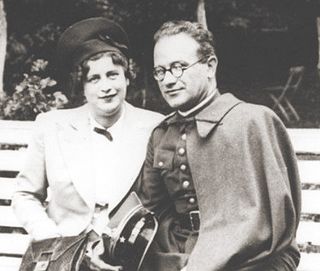
Baruch or Boruch Steinberg was a Polish rabbi and military officer. He was Chief Rabbi of the Polish Army during the German invasion of Poland and Soviet invasion of Poland in 1939 and was executed by the Soviet Union in the Katyn massacre in April 1940.

Andrzej Piotr Pityński was a Polish-American monumental sculptor who lived and worked in the United States. A book of his works was published in 2008.

The Katyń Memorial is a bronze statue created by Polish-American sculptor Andrzej Pitynski in dedication to the victims of Stalin's March 5 1940 Katyn massacre in which thousands of Polish Army officers and intellectual leaders who had been interned at Kozielsk or imprisoned at Ostashkov and Starobielsk had been killed by the occupying Soviet People's Commissariat for Internal Affairs, or NKVD. The memorial stands at Exchange Place in Jersey City, New Jersey, United States, near the mouth of the Hudson River. Unveiled in June 1991, the statue depicts a bound and gagged Polish soldier with a bayoneted rifle impaled through his back. The statue stands 34-foot-tall (10-meter) and is atop a granite base containing Katyn soil. Its base also depicts a Polish woman carrying her starving child in memorial to the Polish citizens deported to Siberia that began shortly before the massacre.
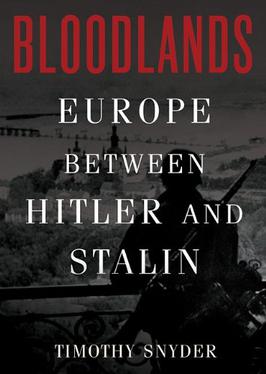
Bloodlands: Europe Between Hitler and Stalin is a 2010 book by Yale historian Timothy Snyder. It is about mass murders committed before and during World War II in territories controlled by Nazi Germany and the Soviet Union.
Grover Carr Furr III is an American professor of Medieval English literature at Montclair State University who is best known for his revisionist views regarding the Soviet Union and Joseph Stalin. Furr has written books, papers, and articles about Soviet history, especially the Stalin era, in which he has stated that the Holodomor, the 1932–33 famine in Soviet Ukraine, was not deliberate, describing it as a fiction created by pro-Nazi Ukrainian nationalists, that the Katyn massacre was committed by the Nazi Schutzstaffel and not the Soviet NKVD, that all defendants in the Moscow Trials were guilty as charged, that claims in Nikita Khrushchev's speech On the Cult of Personality and Its Consequences are almost entirely false, that the purpose of the Molotov–Ribbentrop Pact was to preserve the Second Polish Republic rather than partition it, and that the Soviet Union did not invade Poland in September 1939, on the grounds that the Polish state no longer existed. Furr claims that the mainstream narrative of the Soviet Union and in particular the Stalin era is biased and that many of the claims by mainstream historians are unfounded, because they follow "anti-Stalin paradigm".
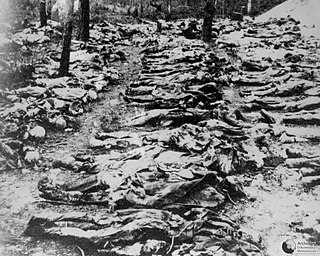
Anti-Katyn is a denialism campaign intended to reduce and obscure the significance of the Katyn massacre of 1940 — where approximately 22,000 Polish officers were murdered by the Soviet NKVD on the orders of Joseph Stalin — by referencing the deaths from disease of thousands of Imperial Russian and Red Army soldiers at Polish internment camps during the Interwar period.

The Last Witness is a British-Polish thriller film directed by Piotr Szkopiak based on a stage play by Paul Szambowski.
This is a select bibliography of English language books and journal articles about the Soviet Union during the Second World War, the period leading up to the war, and the immediate aftermath. For works on Stalinism and the history of the Soviet Union during the Stalin era, please see Bibliography of Stalinism and the Soviet Union. Book entries may have references to reviews published in English language academic journals or major newspapers when these could be considered helpful.
Jane Rogoyska is British writer and filmmaker of Polish origin, best known for her books Gerda Taro: Inventing Robert Capa, Kozlowski, and Surviving Katyn.
This is a select bibliography of English language books and journal articles about the history of Poland during World War II. A brief selection of English translations of primary sources is included. Book entries have references to journal articles and reviews about them when helpful. Additional bibliographies can be found in many of the book-length works listed below; see Further Reading for several book and chapter-length bibliographies. The External Links section contains entries for publicly available select bibliographies from universities. This bibliography specifically excludes non-history related works and self-published books.

Donald Boyle Stewart was a career United States Army officer. He graduated from the United States Military Academy in 1940, fought in North Africa with II Corps, and was captured during the Battle of Sidi Bou Zid on Valentine's Day February 14, 1943. While a captive of the Germans, Stewart and fellow POW Lieutenant Colonel John H. Van Vliet Jr were selected to attend the Katyn Commission investigation into the Polish officers found murdered in the Katyn Forest near Smolensk, Russia. Stewart and Van Vliet Jr were U.S. Registered Code Users who sent coded messages from Oflag 64 to MIS-X in Fort Hunt New Jersey which identified the Soviets as the perpetrators of the massacre. After their liberation, they testified before the United States House Select Committee to Conduct an Investigation of the Facts, Evidence, and Circumstances of the Katyn Forest Massacre about their experiences at the Katyn Commission exhumations.

John H. "Jack" Van Vliet Jr was a career United States Army officer. He graduated from the United States Military Academy (U.S.M.A.) in 1937, fought in North Africa with II Corps, and was captured during the Battle of Sidi Bou Zid on February 17, 1943. While a captive of the Germans, Van Vliet Jr and fellow POW Captain Donald B. Stewart were selected to attend the Katyn Commission investigation into the Polish officers found murdered in the Katyn Forest near Smolensk, Russia. Van Vliet Jr and Stewart were U.S. Registered Code Users who sent coded messages from Oflag 64 to MIS-X in Fort Hunt New Jersey which identified the Soviets as the perpetrators of the massacre. After their liberation, they testified before the United States House Select Committee to Conduct an Investigation of the Facts, Evidence, and Circumstances of the Katyn Forest Massacre about their experiences at the Katyn Commission exhumations.
References
- ↑ "Northern Illinois University Press" . Retrieved 2010-02-07.
- 1 2 "Allen Paul, Author of Katyń, Receives the Commander's Cross of the Order of Merit". Washington, DC: U.S. Department of State. 15 April 2009. Archived from the original on May 28, 2010. Retrieved 28 January 2010.
- 1 2 3 "Allen Paul". Archived from the original on 2010-03-17. Retrieved 8 February 2010.
- ↑ Good, Jane E. (Nov 24, 1991). "Slaughter in a Polish Wood". The Washington Post. Archived from the original on June 4, 2011. Retrieved 29 January 2010.
- ↑ Kenney, Michael (Aug 26, 1991). "Investigating the Slaughter of Poland's Best and Brightest". Boston, MA: The Boston Globe. p. 39. Archived from the original on July 19, 2012. Retrieved 29 January 2010.
- ↑ The New York Times, September 1, 1991, p. 11
- ↑ Publishers Weekly, July 5, 1991
- ↑ "KATYN: The Untold Story of Stalin's Polish". Kirkus Reviews. Aug 15, 1991. Retrieved 29 January 2010.[ dead link ]
- ↑ Dziennik Polski Kronika Krakowsk, April 14, 2006
- ↑ Poremski, Richard P. (1 December 2009). "'Katyn' Author Allen Paul Decorated". Polishsite.us. Retrieved 28 January 2010.